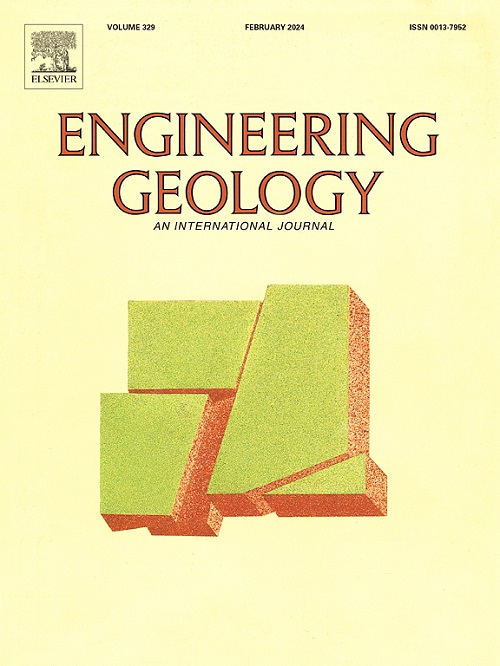Correlation between deep and surface deformations of excavated slopes on the margins of strike-slip fault-depression basins under rainfall conditions
IF 6.9
1区 工程技术
Q1 ENGINEERING, GEOLOGICAL
引用次数: 0
Abstract
The margins of strike-slip fault-depression basins present intricate challenges facing slope stability in engineering due to the distinctive geological structures and geomorphic attributes of these formations. Particularly during periods of precipitation, there are often significant correlations between deformations occurring at depth and those occurring at the surface, which poses a significant threat to the stability and safety of excavated slopes. Despite extensive research on the phenomena and patterns of such deformations along strike-slip fault-depression basin margins, the correlations remain complex and challenging to quantify using simple field monitoring and mechanical models. This challenge significantly hampers a thorough understanding of these correlations, particularly when considered alongside the uncertainty of rainfall effects and the complexity of geological structures. As a result, it has a detrimental impact on the scientific and precise design and construction of slope engineering in these regions. To address this challenge, this study presents a machine learning-based analysis approach that uses a feedforward neural network to investigate the correlations between deep and surface deformations in excavated slopes under rainfall conditions. By employing rainfall as the primary input variable, the correlation model is utilized to predict and analyze these deformations, thereby elucidating the mechanism of the impact of rainfall on these correlations and the relevant quantitative relationship. The proposed approach is implemented in a typical excavated slope case along the strike-slip fault-depression basin margins, yielding satisfactory results (R2: 0.89–0.96). This study provides valuable insight and guidance for the prevention and mitigation of deformation and failure in excavated slopes in strike-slip fault-depression basins and similar geological settings.
降雨条件下走滑断陷盆地边缘开挖边坡深部与地表变形的相关性
走滑断陷盆地边缘由于其独特的地质构造和地貌属性,在工程上给边坡稳定性带来了复杂的挑战。特别是在降水期间,深层变形与地表变形之间往往存在显著的相关性,这对开挖边坡的稳定和安全构成了重大威胁。尽管对沿走滑断陷盆地边缘的这种变形现象和模式进行了广泛的研究,但相关性仍然很复杂,很难用简单的现场监测和力学模型来量化。这一挑战极大地阻碍了对这些相关性的彻底理解,特别是在考虑到降雨影响的不确定性和地质结构的复杂性时。这对这些地区边坡工程的科学、精确设计和施工产生了不利影响。为了应对这一挑战,本研究提出了一种基于机器学习的分析方法,该方法使用前馈神经网络来研究降雨条件下开挖边坡深层和地表变形之间的相关性。以降雨为主要输入变量,利用相关模型对这些变形进行预测和分析,从而阐明降雨对这些相关性的影响机制及其定量关系。将该方法应用于典型的走滑断陷盆地边缘开挖边坡实例,得到了满意的结果(R2: 0.89-0.96)。该研究为走滑断陷盆地及类似地质背景下的开挖边坡变形破坏的防治提供了有价值的见解和指导。
本文章由计算机程序翻译,如有差异,请以英文原文为准。
求助全文
约1分钟内获得全文
求助全文
来源期刊

Engineering Geology
地学-地球科学综合
CiteScore
13.70
自引率
12.20%
发文量
327
审稿时长
5.6 months
期刊介绍:
Engineering Geology, an international interdisciplinary journal, serves as a bridge between earth sciences and engineering, focusing on geological and geotechnical engineering. It welcomes studies with relevance to engineering, environmental concerns, and safety, catering to engineering geologists with backgrounds in geology or civil/mining engineering. Topics include applied geomorphology, structural geology, geophysics, geochemistry, environmental geology, hydrogeology, land use planning, natural hazards, remote sensing, soil and rock mechanics, and applied geotechnical engineering. The journal provides a platform for research at the intersection of geology and engineering disciplines.
 求助内容:
求助内容: 应助结果提醒方式:
应助结果提醒方式:


